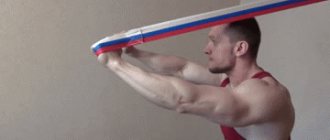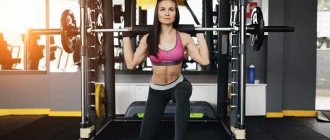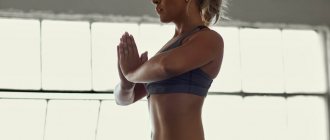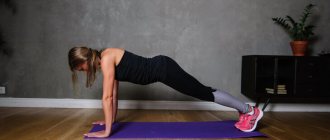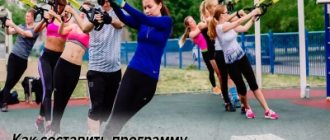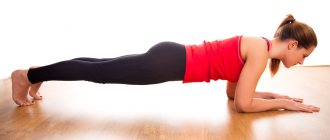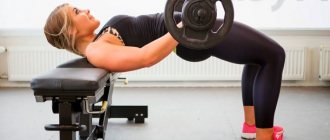Is it possible to pump without weights?
Yes, to a certain extent. “Depending on how intensely you train, doing bodyweight exercises , you can achieve the following results: increase muscle tone, pump up your arms, increase energy expenditure to reduce body fat and overall body weight (a prerequisite for relief), increase endurance, increase flexibility,” comments Edward Kazaryan, expert in X-Fit group programs in Russia .
bodyweight exercises alone . own weight,” says Elena Chindyaeva, personal trainer, author of the Instagram blog @chindaeva_fit , nutrition consultant . “To do this, you need to add weights, work with equipment, additional weight and adhere to a different type of diet - with a calorie surplus.”
This is due to the peculiarities of our body’s functioning. “We use the musculoskeletal system every day, and our muscles have the characteristics that are necessary to work specifically with your weight. Therefore, by exercising without weights, it is impossible to significantly increase muscle mass,” notes Edward Kazaryan.
But there will still be a positive effect from exercise without weights. Firstly, by intensely training with your own body weight, you can get rid of puffiness, which will already lead to some reduction in volume. “Secondly, you will be able to increase muscle tone to get your body in shape. By training in different intensity zones (it depends on the number of exercises, repetitions, duration of rest), you will develop your endurance and be able to increase calorie expenditure, adds Edward Kazaryan. “The big plus is that with good exercise control, your workouts create a stimulus for the development of all muscles, ligaments and joints, and this makes the body more functional.”
And strength exercises with your own weight are a good basis for weight training. That is, if you have no experience in fitness at all, then after working out without weights for a couple of months, you can move on to full-fledged strength training in the gym. Because learn the correct technique for performing basic exercises and allow your nervous system to adapt to periodic physical activity.
General principles and rules for training
The main principle of any strength exercise, including with your own weight, is that each workout should focus on a specific muscle group .
Rules for the training:
- Always start with a warm-up for 7-10 minutes.
- The optimal duration of one workout is 60-90 minutes.
- The number of approaches for each exercise is 4.
- The number of repetitions in each approach is from 10 to 20.
Bodyweight training program: safety precautions
If you ignore some rules, you can get injured. “Warming up at the beginning of training, joint exercises, increasing body temperature, heart rate, and correct exercise technique are required. You should gradually complicate the training, building exercises from simple to complex,” says Elena Chindyaeva.
Pay special attention to the technique of doing the exercises. “Control your movements as much as possible. You must clearly understand what you are doing and how. Avoid completely unfamiliar exercises, adds Edward Kazaryan. - Maintain a long, elongated spine. Do lumbar and neck stabilization exercises.”
Pectoral muscles
Dips on the parallel bars emphasize the load on the lower chest.
Focus on putting more stress on your chest and less stress on your triceps.
Another exercise that everyone is familiar with from school is push-ups. It's essentially a bench press in reverse. There are several variations of push-ups. If the legs are located higher than the body, the load falls more on the upper chest. If the torso is raised, it’s the opposite. A narrow arm position puts more stress on the inner chest and triceps.
Bodyweight exercises at home: how to increase the load
It is important to gradually increase the load as the body adapts to it. To do this, according to the advice of Edward Kazaryan, work with the following parameters:
- Number of repetitions . “Increase their number in each approach. In the first week, do 15 repetitions, and in the second, 20, and so on,” says Edward Kazarian.
- Number of approaches. Do not two approaches, but three.
- Duration of rest. “If you are a beginner, first rest 2 minutes between exercises. After a month, reduce the break to one and a half minutes, then to one,” the expert advises.
- Speed of exercises. By performing familiar movements faster, you also increase the intensity. However, remember about safety precautions. “It is important that you make a fast movement as clearly as a slow one. You need to learn this gradually,” adds Edward Kazaryan.
Bodyweight training can also be based on the interval principle, that is, performing exercises for a certain period of time. This method is effective for losing weight. A workout from Jacqueline Wood, a fitness trainer and blogger from the USA, was designed based on this principle. We invite you to try it today.
How to build a lesson
- Start your workout with a light warm-up.
- Perform the exercises consistently for the specified amount of time.
- Finish your workout with stretching.
- Do this program 2-3 times a week.
To complete the complex you only need a mat.
Upper body workout
As part of the upper body workout, efforts are aimed at pumping up the shoulders, chest and arms: push-ups (forward and reverse), biceps exercises.
Push ups
The best exercise for bodyweight training, the push-up, is performed as follows:
- 2 seconds while inhaling, move down;
- 1 second pause;
- 2 seconds while exhaling, move upward.
Then it repeats without a pause.
Options:
- narrow or wide hand position (grip);
- lifting with a push and clap of hands;
- push-ups on one hand (with and without support).
As you can see, this exercise presents the opportunity to use variations with different levels of load.
Reverse push-ups
Reverse push-ups target the same muscles as straight ones - pectoral, anterior deltoid, triceps. By changing the geometry of the body, it is possible to shift the emphasis and make the training more effective.
Starting position: legs on one bench, arms on the opposite bench, body suspended, the angle between the hip and torso tends to 90 degrees.
Important tips for implementation:
- Don't go too low as this can cause shoulder injury.
- Do not spread your elbows to the sides.
- Chest forward. Don't slouch.
Biceps exercise
A bodyweight training program for men necessarily includes close-grip (“chin-up”) pull-ups. Beginners should do a minimum number of repetitions, since the exercise involves lifting a lot of weight without support.
Tips for implementation:
- The position of the hands is as close to each other as possible. Palms to face.
- Leg position – ankles crossed. It is also recommended to bend your knees.
A set of exercises with your own weight
Almost all exercises in the complex must be performed continuously for 45 seconds. Then you should rest for 15 seconds.
At first, it may be difficult for you to maintain a fast pace of exercise, but that's okay - work at your own rhythm. The main thing is to strictly follow the technique of performing the exercises. Over time, you will be able to increase speed and thereby increase the load.
Squat Steps
Stand up straight, place your feet together. Bend your knees slightly and move your pelvis back. Place your hands in front of your chest and actively work your abdominal muscles. From this position, step left with your left foot, then step right with your right. Then return to the starting position, bringing your feet together. This is one repetition. Complete a maximum of these in 45 seconds. Then rest for 15 seconds.
Jumping Jack
Stand straight, feet hip-width apart, bend your arms and bring your palms together in front of your chest. Work the muscles of your legs, back, arms and abs. Jump, spread your feet wider than your shoulders, raise your arms (without opening your palms) above your head. Jump your feet together and return to the starting position, lowering your palms in front of your chest. This is one repetition, complete a maximum of these repetitions in 45 seconds. Then rest for 15 seconds.
Lunge bends
Stand straight, feet hip-width apart, arms along the body. Step your right foot forward and bend your knees, lowering into a lunge. Lean your body forward, lower your arms forward and down. Having fixed the position of the body, bend your knees more, lowering yourself into a lower slope due to the work of your legs and buttocks. Then straighten your knees, returning to the starting position. This is one repetition. Do a maximum of these in 45 seconds, then rest for 15 seconds and do the same thing, stepping forward with your left foot. After 15 seconds of rest, move on to the next exercise.
Diagonal press crunch
Lie on the floor, legs straight, arms extended along the body. Press your right hand to the floor, bend your left at the elbow and move it behind your head. Working your abdominal muscles (try to keep your legs relaxed), simultaneously lift your body and right leg above the floor, and with your left hand reach for your right foot. Rest your right palm on the floor, do not slouch or strain your neck. Return to the starting position. This will amount to one repetition. Do a maximum of these in 45 seconds, then rest for 15 seconds and do the same on the other side. After 15 seconds of rest, move on to the next exercise.
Simplified burpee
Stand straight, feet shoulder-width apart. Bend your knees slightly and lean your body forward. Place your palms on the floor and distribute your body weight between your hands and feet. Work the muscles of your abs, legs, back and arms. Jump your feet back and get into a plank position. Then jump with your feet closer to your palms, bend your knees slightly, assume a vertical position and extend your arms in front of you. This is one repetition. Perform a maximum of these in 45 seconds, then rest for 15 seconds.
Squats-springs
Stand straight, feet shoulder-width apart. Bend your knees slightly and move your pelvis back, working your abs, legs and hips. Don't arch at the waist. Then smoothly return to the starting position. This is one repetition, complete in a maximum of 45 seconds. Rest for 15 seconds and move on to the next exercise.
Squat Jumps
Stand straight, feet shoulder-width apart. Bend your knees and push your pelvis back, lowering into a squat, working your abs, legs and hips. Bring your hands together in front of your chest. Don't arch at the waist. Jump up from the squat. Land in a vertical position and lower back into a squat. This is one repetition. Perform a maximum of these in 45 seconds, then rest for 15 seconds.
Asymmetrical push-ups
Get down on your knees, place your palms under your shoulders. From this position, slide your right palm 30 cm forward. Bend your elbows and perform a push-up (at the bottom of the movement, your right forearm will touch the floor). Then return to the starting position. This is one repetition. Perform a maximum of these in 45 seconds, then rest for 15 seconds. After this, repeat the same on your left hand, then rest and move on to the next exercise.
"Fold"
Sit on the floor with your legs straight. Stretch your arms above your head. Lean your body back slightly, lift your legs off the floor (knees slightly bent), pulling your hips closer to your stomach. At this moment, lower your arms down through your sides and bring your palms together under your hips. Then return to the starting position - legs on the floor, arms above your head. This is one repetition. Perform a maximum of these in 45 seconds, then rest for 15 seconds.
Squats and cross jumps
Stand straight, feet shoulder-width apart. Bend your knees and push your pelvis back, lowering into a squat, working your abs, legs and hips. From this position, jump up and land on your feet, crossing your ankles. Then jump up again and land with your feet parallel to each other, hip-width apart. Lower yourself into a squat. This is one repetition. Perform a maximum of these in 45 seconds, then rest for 15 seconds.
Squat Jumps
Get on your knees with your feet shoulder-width apart. Place your hands in front of your chest, your abs active. Maintaining the position of the body, place first your left and then your right feet on the floor and go into a squat. From this position, jump up. Land in a squat and lower your knees down one at a time to stand on them. This is one repetition. Perform a maximum of these in 45 seconds, then rest for 15 seconds.
Jumping lunges
Stand straight, feet shoulder-width apart. Bend your knees and push your pelvis back, lowering into a squat, working your abs, legs and hips. Bring your hands together in front of your chest. From this position, step to the left (keep your knees slightly bent), then jump up. Then return to the starting position (squat) and step to the right. Jump again. Return to the starting position. This is one repetition. Perform a maximum of these in 45 seconds, then rest for 15 seconds.
Fold with alternating leg bends
Sit with your legs straight, lean your body back. Work your abdominal muscles. Raise your legs above the floor, bending your left knee, and lean your body forward (pulling your left thigh towards your stomach). Then lean your body back again, straighten your left leg and bend your right, also pulling your thigh towards your stomach. This is one repetition. Perform a maximum of these in 40 seconds, then rest for 15 seconds.
Triceps push-ups
Stand in a plank position with straight arms, placing your palms under your shoulders. Work your abs, back and leg muscles. Bend your elbows and point them closer to your body, lower yourself towards the floor. Then smoothly return to the starting position. This is one repetition. Complete a maximum of these in 30 seconds. Rest for 10 seconds and move on to the next exercise.
Rotation fold
Lie on your back, stretch your legs up (point your toes towards you). Place your hands behind your head, press your lower back to the floor. As you exhale, lift your neck and head above the floor, twist your body slightly forward and to the left, extend your right arm up and try to touch your left foot with your right palm. Leave your left elbow bent and touch the floor. Then return to the starting position, twist forward and to the right, touch your left palm to your right foot. Return to the starting position, this is one repetition. Complete a maximum of these in 45 seconds, rest for 15 seconds, and move on to the next exercise.
Lunge Jumps
Stand straight, feet shoulder-width apart. Step your left foot forward, bend your knees slightly, and lower into a lunge. Place your arms along your body. Work the muscles of your legs, back and abs, do not slouch or arch your lower back. From this position, push your feet off the floor, jump up and land back into a lunge. This is one repetition, complete a maximum of these in 45 seconds, rest for 15 seconds. Then do the same on the other side. After 15 seconds of rest, move on to the next exercise.
Swing your legs
Stand straight, feet shoulder-width apart. Place your palms in front of your chest, bending your elbows. Work your abs, legs, and back muscles. Don't slouch. Shift your body weight to your left leg, extend your right leg to the side, raising your foot as high as possible. Then smoothly return to the starting position, this is one repetition. Perform a maximum of these in 45 seconds, rest for 15 seconds. Then repeat the same on the other side. After 15 seconds of rest, move on to the next exercise.
Swing your legs while lying down
Sit with your legs straight, lean your body back and lean on your forearms. Bend your legs slightly at the knees and lift them off the floor. Extend your right leg up and your left leg parallel to the floor. Work your abdominal and leg muscles, don't slouch, relax your neck. Then return to the starting position and extend your left leg up and your right leg parallel to the floor. Return to the starting position again. This is one repetition, complete as many as you can in 45 seconds, then rest for 15 seconds.
Gluteal bridge
Sit on the floor, place your palms behind your body. Bend your knees, rest on your feet. Push your pelvis up until your body is parallel to the floor. This is the starting position. Work your abs, back muscles, arms and legs. From this position, lower your pelvis down (do not touch the floor with your buttocks) and lift it up again. This is one repetition. Perform a maximum of these in 45 seconds, then rest for 15 seconds.
"Balancing fold"
Lie on the floor, raise your legs up, bend your knees. Place your hands behind your head. Working your abdominal muscles, straighten your legs, smoothly twist your body forward, try to reach your feet with your hands, maintain balance. Then also slowly and smoothly return to the starting position: lower your body to the floor. This is one repetition. Perform a maximum of these in 45 seconds, then rest for 15 seconds.
"Crab"
Sit on the floor, place your palms behind your body. Bend your knees, rest on your feet. Push your pelvis up until your body is parallel to the floor. This is the starting position. Lower your pelvis down a little, then lift and simultaneously extend your right arm and left leg upward, try to touch your foot with your palm. Lower your pelvis again and, pushing it up, extend your left arm and right leg up at the same time. This is one repetition. Perform a maximum of these in 45 seconds, then rest for 15 seconds.
Don't chase speed, work at your own pace and pay attention to the technique of doing the exercises. Only after honing it can you try to increase the pace of the lesson.
Rule 1. Increase the load
All bodybuilders gradually increase the load so that the muscles continue to grow. When you use external resistance, it doesn't require imagination or creativity. You just need to add weight to the barbell, take dumbbells or heavier kettlebells.
For those who train with their own weight, this is a little more difficult. Since you can't instantly increase your body mass, you will have to modify the exercise itself. Here are some options:
- Increase the difficulty of the exercises . Elevated push-ups can be replaced with handstand push-ups. There is always a more difficult version of the exercise.
- Increase the final load on the limb . Replace lunges with single-leg squats. The load on the leg will increase.
- Increase your range of motion . If you're good at chin-up, try chest-length pull-ups.
